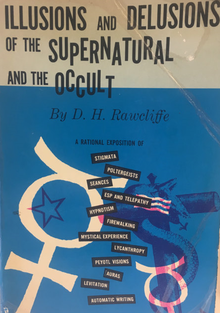 Cover of Illusions and Delusions of the Supernatural and the Occult, 1959. | |
| Author | Donovan Hilton Rawcliffe |
|---|---|
| Subject | Occult, psychology |
| Publisher | London: Ridgway / New York: Dover Publications |
Publication date | 1952, 1959, 1988 |
| Media type | psychology |
The Psychology of the Occult is a 1952 skeptical book on the paranormal by psychologist D. H. Rawcliffe. It was later published as Illusions and Delusions of the Supernatural and the Occult (1959) and Occult and Supernatural Phenomena (1988) by Dover Publications. Biologist Julian Huxley wrote a foreword to the book.[1]
YouTube Encyclopedic
-
1/5Views:24 2412 535 6684 998 455521 568636 759
-
The Occult
-
How To Analyze People On Sight - FULL AudioBook - Human Analysis, Psychology, Body Language
-
Why do people join cults? - Janja Lalich
-
Humanity's Deepest, Darkest Fear
-
1/2 The Art of Witchcraft - Secret Knowledge
Transcription
Content
The book takes influence from the works of Frank Podmore, Joseph Jastrow and Ivor Lloyd Tuckett dealing with the "fallacies underlying psychical research". Rawcliffe critically examines claims of the occult, parapsychology and spiritualism concluding that they are best explained by psychological factors such as hallucination, hysteria, neurosis and suggestion as well as "delusion, fraud, prestidigitation, and limitless credulity."[2] Rawcliffe found possible naturalistic explanations for all parapsychological experiments he investigated, noting that there is no scientific evidence for any paranormal power. He suggested that many of the results from ESP experiments can be explained by what he termed endophasic enneurosis (unconscious whispering).[3]
The book offers rational explanations for diverse phenomena such as automatic writing, dowsing, fire-walking, lycanthropy and stigmata.
Reception
Daniel Loxton has described the book as an important skeptical work written many years before the founding of CSICOP. He noted that "Much as Michael Shermer has done in recent decades, Rawcliffe attempted not merely to debunk these claims, but to explain the underlying psychology of why people believe weird things."[4]
See also
References
- ^ Anonymous. (1959). The Psychology of the Occult. Science Digest 46: 194.
- ^ Tulving, Endel. (1960). Review of Illusions and Delusions of the Supernatural and the Occult. Canadian Journal of Psychology 14 (4): 286–287.
- ^ Dingwall, Eric. (1952). Psychical Research Dissected. Nature 170: 176–177.
- ^ Loxton, Daniel. (2013). "Why Is There a Skeptical Movement?". Retrieved 4 June 2017.
